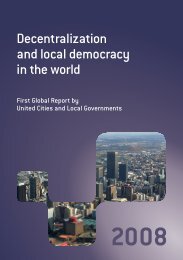Making Cities Resilient Report 2012
Making Cities Resilient Report 2012
Making Cities Resilient Report 2012
You also want an ePaper? Increase the reach of your titles
YUMPU automatically turns print PDFs into web optimized ePapers that Google loves.
CHAPTER 4 | What are local governments doing to build resilience<br />
Disaster risk reduction and climate change<br />
Few cities have an action programme to address climate change adaptation separately from disaster risk<br />
reduction. Some cities have set out the terms of a comprehensive adaptation strategy, but with limited<br />
detail on specific adaptation activities. Adaptation is mostly limited to education campaigns and symbols of<br />
political commitment to adaptation, as part of citywide climate change strategies, plans and pledges.<br />
Many cities focus on climate change mitigation, which does little lower local risk, but does contribute to<br />
slowing down dangerous climate change at a global level. These mitigation measures focus on energy<br />
conservation (for example, use of more efficient lighting or promoting renewable energy options in Bangkok)<br />
and reducing greenhouse gases (for example, using rice hulls in place of fossil fuels in a cement factory in<br />
Albay Province), or planting trees in Bhubaneswar.<br />
Adopting climate change action plans is a first step in most cities. Quito was among the first to formulate a<br />
climate change strategy with a schedule for compliance. Cape Town, Johannesburg and Durban are among<br />
the cities that have led the way in developing climate change adaptation strategies. Cairns adopted its<br />
Climate Change Adaptation Plan 2009, which included a qualitative risk assessment and recommendations<br />
for a range of appropriate responses (46). Bangkok adopted a five-year ‘Climate Change Action Plan in<br />
2007, although the activities focused on mitigation (43). Albay Province’s Action on Climate Change (A2C2)<br />
programme includes education and awareness programmes (the links between disaster risk reduction and<br />
climate change adaptation are emphasised in school disaster risk reduction education and teachers are<br />
trained so they can pass information on to their students, sector-specific climate smart programmes for<br />
health, housing, water sanitation and hygiene, and resilient livelihoods).<br />
9. Effective Preparedness,<br />
Early Warning and Response<br />
Essential 9: Install early warning systems and emergency management capacities in your city and hold<br />
regular public preparedness drills<br />
There is wide recognition among cities that emergency preparedness, early warning systems and disaster<br />
response structures are vital for reducing the number of deaths and injuries caused by rapid-onset<br />
disasters. Most cities have taken some action in this area. Some have sophisticated, integrated monitoring<br />
and warning systems, with teams of professional and volunteer personnel trained in emergency response<br />
and with effective measures to reach the public with early warnings. Others have a more basic level of<br />
preparedness, consisting of simple forecasting and monitoring techniques and more limited capacity<br />
to reach the public. The more sophisticated systems generally have a central coordinating body that<br />
oversees the integration of monitoring, warning and response.<br />
Most cities have conducted simulation exercises or evacuation drills to raise the level of citizen preparedness<br />
and have sought to provide some type of facility for emergency situations – either constructing evacuation<br />
centres or stockpiling resources. A common challenge is inadequate communications infrastructure to<br />
disseminate early warning messages, although some cities have found innovative ways to overcome this.<br />
Emergency planning and preparedness<br />
Emergency planning seeks to ensure that when a disaster occurs or is imminent, city institutions,<br />
organisations, schools and general public have the knowledge and capabilities to be able to reach a place<br />
of safety and/or escape injury or death.<br />
Many cities undertake drills and simulation exercises to increase public and organisational preparedness<br />
for emergencies. Quito carries out drills and simulations at the institutional level as well as in communities<br />
<strong>Making</strong> <strong>Cities</strong> <strong>Resilient</strong> <strong>Report</strong> <strong>2012</strong> | 61

















